
A wasp trap is perhaps the most effective and easiest way to get rid of insects on the site, if their nest itself is located outside it. Moreover, such traps help not only in the country, in the garden or garden, but especially in the apiary, where wasps often actively hunt bees. Just a few correctly made traps in a relatively short period of time can significantly reduce the number of wasps on the site.
Next, we will look at how you can make a wasp trap with your own hands, and it will work in such a way that you yourself will be surprised how simple and at the same time very effective design it is. To make it, it is enough to have an empty plastic bottle of mineral water, scissors, as well as wire or tape on hand. The very manufacture of one product will take several minutes on the strength, and such a trap for wasps from a bottle often works even more efficiently than expensive store counterparts.
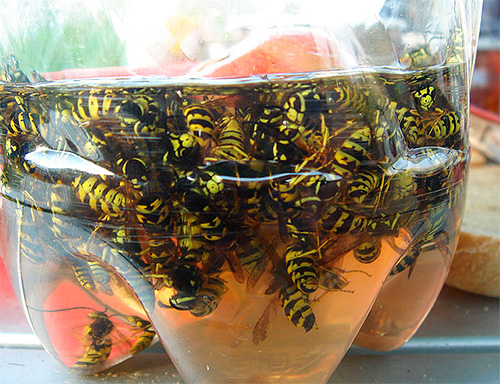
By the way, we note that many standard insect traps have practically no effect on wasps.For example, lamp devices, which are very effective against mosquitoes, flies and moths, do not attract wasps at all, and even when located directly near the vineyard, they catch only insects that accidentally fly into them. The do-it-yourself trap, which will be discussed later, first effectively lures wasps (more effectively than, for example, grapes or blackberries on a bush), and then destroys them.
Important!
Even before you make a trap for wasps, it will be useful to make sure that insects have not settled on the site or in outbuildings by organizing their nest here. To do this, you need to observe where the insects fly after feeding on berries or grapes, and for reliability, carefully check the little-visited attics, sheds and sheds. If there is a nest on the site, it is enough just to destroy it so that the wasps no longer disturb - this will solve the problem in just a couple of hours. However, if you are afraid to get too close to the nest, then traps will come in handy in this case, just in time...
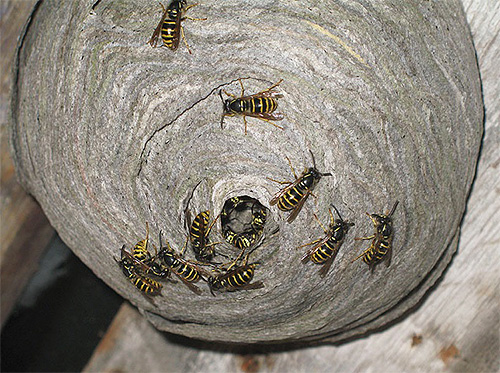
Do-it-yourself wasp traps: principles of operation and materials used
So, let's now take a closer look at how to make a wasp trap with your own hands using an empty two-liter plastic bottle.
The production order is as follows:
- Cut off the top third of the bottle with a neck with scissors or a knife.

- Bait is poured into the bottom of the bottle.
- A lid is twisted from the cut off part.
- Next, the cut off upper part of the bottle is turned upside down and inserted into the lower one (if the bottle has different diameters at different heights, cut it off so that when turned over, the upper part becomes tightly enough into the lower one).

- Slightly above the level of the bottom of the neck in the trap, you can additionally make small holes (however, this is not necessary). They are needed so that the smell of the bait comes out of the bottle better and spreads around, but the insects themselves should not be able to climb through these holes.
- If the trap is planned to be hung on tree branches, two holes are made in the upper part of the resulting structure from different sides, into which a wire loop is inserted - a handle is obtained.
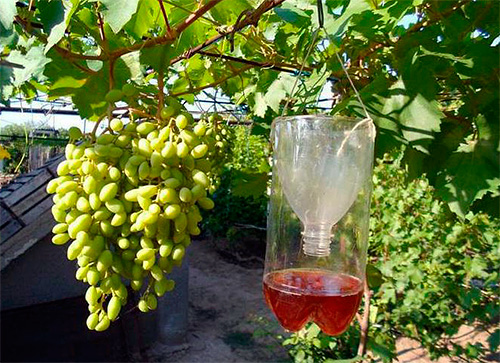
Important!
A bottle volume of 2 or 5 liters will be optimal if a universal wasp and hornet trap is required. The fact is that with a large number of them, several tens and even hundreds of insects can get into the bottle in one day, so smaller traps simply cannot accommodate such a number of “guests”. If you need a trap only for paper wasps, you can take a bottle of a smaller volume, for example, 1.5 liters.
The principle of operation of a homemade trap is simple: a wasp, attracted by a pleasant aroma for it, crawls through a funnel into the inside of the bottle, feasts on the bait, and then tries to fly out, either instinctively flying up or crawling to the top of the trap along the inner wall. In any case, the insect rests against the junction of two parts of the bottle and the "biological algorithms" simply do not allow the wasp to make a saving path along the neck of the funnel to the exit from the trap.
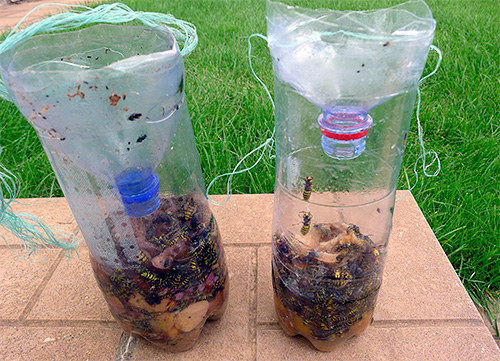
Very often, such traps are placed by experienced summer residents under tables on verandas or in summer kitchens, since wasps are strongly attracted to the tables by the smells of cooking products, especially fish. Here, the traps are simply taped to the table legs with adhesive tape.
Review
“In the summer we had to hang about ten traps at the dacha, there were so many wasps. They are caught regularly, every day they had to shake out the bottles. True, there were fewer of them only after a week or two, because there were too many of them. But without any chemistry and bites, like others.
Valentina Petrovna, Kolomyia
It must be borne in mind that one trap for wasps in an apiary or in a large area (more than 5 acres) will not help. Here you need to use at least 5-6 of them, placed evenly over the territory.
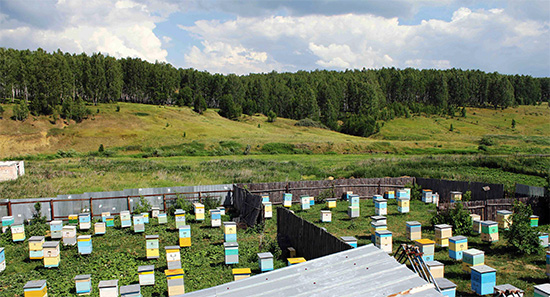
However, if you read carefully, making the above construction with your own hands is only part of the task. A modified bottle turns into a trap only after it is placed in the right effective bait that can attract wasps.
Properly preparing the bait for the trap
As a bait for wasps and hornets in traps, they usually use mash, kvass, beer (possible with sugar), fermented jam, honey diluted with water, watermelon juice or compote. They are poured into the trap so much that there is some distance left to the bottom of the neck.
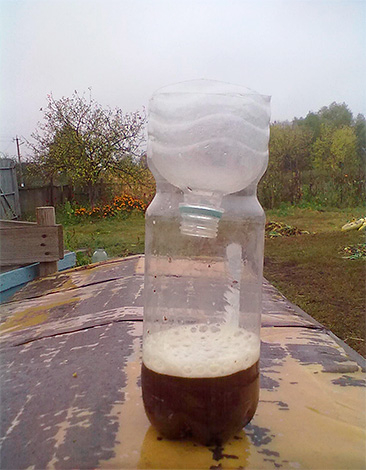
Important!
The choice of bait must be treated very responsibly. It should not attract bees, which are very important for pollinating plants in the garden and in the garden. Therefore, sugar syrups or fresh jams, especially in the apiary, are undesirable to pour into the trap. On Braga or beer, bees do not flock.
Traps for wasps in the country can also be filled with baits with poisonous substances. Firstly, even single wasps that get out of the trap will die after feeding with such bait. And secondly, even being caught, already in a trap, live wasps would not allow them to be shaken out calmly (imagine - to shake out two hundred still living wasps).When using an insecticidal additive in the bait, insects die very quickly, they can be removed, and the trap can be hung again for work.
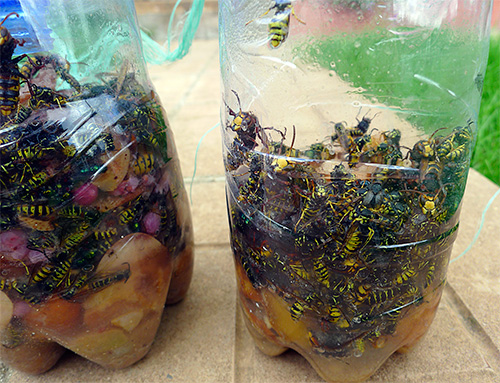
Poisoned bait for the trap can also be made by hand. To do this, boric acid is added to standard kvass, beer or compote and thoroughly mixed, or you can buy effective insecticidal preparations that are odorless - they work even better. These tools include, for example, Get, Lambda Zone, Delta Zone. These are not very expensive means and they last for a long time.
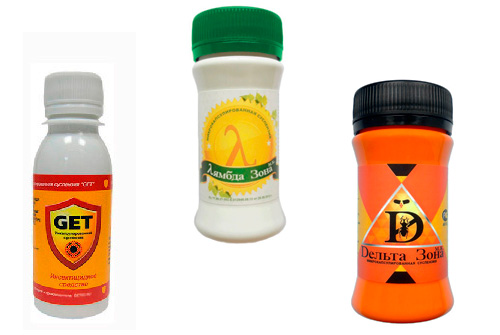
You can also use a special drug Otos as a bait. It is sold in 10 gram bags, and the contents of each bag is enough for one trap. The powder is simply poured into a bottle and poured with half a glass of warm water, then mixed. After 2-3 hours, the mixture will begin to smell and attract wasps, and the bees do not flock to such a bait.
Purchased items: types, prices and reviews
If you don’t want to mess around with making a wasp trap yourself, then you can buy it. For example, the following models are actively sold in agricultural stores or via the Internet today:
- The Wasp Trap is a wide plastic trap with a clear top and colored bottom. It has special entrances directed inwards and upwards, and these entrances are no longer found inside the wasps. The Wasp Trap trap has a convenient mount for hanging on branches, and costs about 400 rubles.

- Swissinno, swiss made trap. Works pretty much the same as Wasp Trap but looks like a neat bucket. Sold already with a bait that does not attract bees. It also costs about 400 rubles.

- GUARD'n CARE made in China by order of the Dutch concern is a product with several compartments of different widths. It costs about 350 rubles.
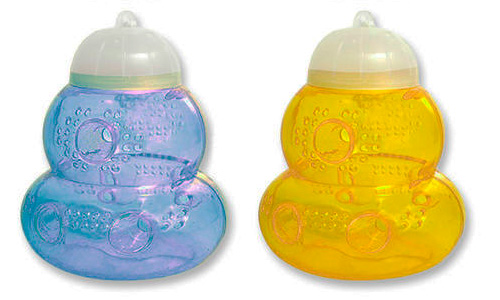
All of these traps are quite effective, and the price does not reflect their quality. You can buy either the one that is cheaper and easier to deliver, or the one that is available (we recommend giving preference to the Swissinno trap).
Review
“We suffered from wasps this summer. They made a nest in the fence at the dacha, and my daughter and I arrived a day earlier than my husband. Well, we were bitten once on the first day. I called my husband, he arrived with a purchased trap. Such a bucket with holes on the sides. They hung it right next to the nest, poured sweet compote there. Wasps were caught for several days, until the whole trap was filled, but there was no special sense from this. All the same, the rest flew. It ended with the husband pouring gasoline on their nest at night and burning it.
Yana, Kirov
Sticky wasp traps
Another way to catch wasps in the country is to do it with sticky tapes designed for flies. Such tapes are hung in places where wasps are most concentrated, and sooner or later the insects sit down on them to rest, stick and die.

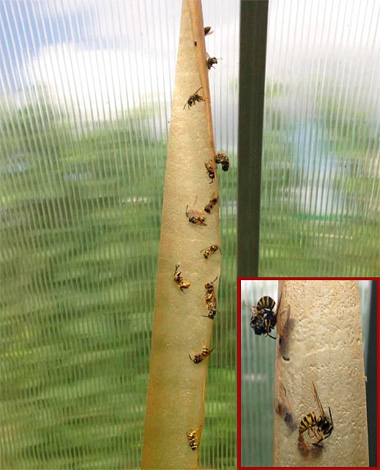
Tapes have their advantages and disadvantages. Their main advantages are low cost, availability and ease of use. They don't even need bait! But the disadvantages of sticky traps include the fact that not only wasps can stick to them, but also bees, butterflies, riders, beetles and a bunch of other, sometimes useful insects. Another disadvantage is that sticky tapes do not particularly attract wasps.
In addition, adhesive tapes should be hung in a visible and free from other objects places.By themselves, they have an unsightly appearance, and being covered with wasps, flies and mosquitoes, still moving, they are a frankly repulsive sight. Therefore, in most cases, bottle traps that can be camouflaged or placed under a table or in the thick of foliage are preferable to tape.
Practice has shown that sticky tapes do not effectively catch hornets: these insects can break away from Velcro, which, in fact, is intended only to hold flies.
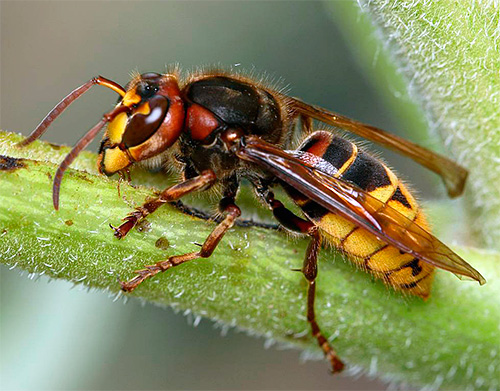
In the apiary, special adhesives can be used to protect the hives, which are used to catch cockroaches in houses or caterpillars in gardens. The glue is applied in a thin layer on cardboard or plywood, and the entire trap is placed on a hive or other prominent place. For reliability, you can put a piece of watermelon or peach inside it. Even a hornet will get stuck in such a mass of glue.
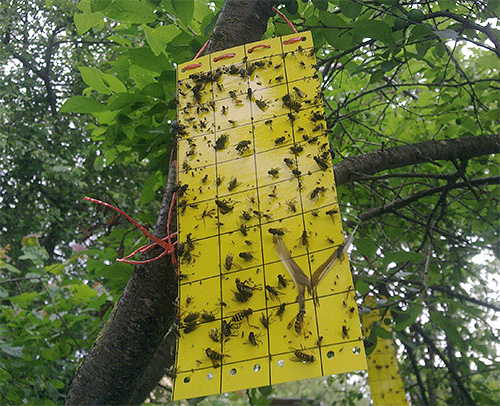
From wasps, for example, the following adhesives can be used:
- RaTrap, a 135 ml tube of which costs about 80 rubles.
- Clean House at a price of 60 rubles per 60 grams;
- ALT, about 200 rubles for 135 grams.
For the manufacture of one sticky trap, 100-120 grams of glue is enough.
Important!
In the apiary, you need to carefully monitor so that bees do not fall into sticky traps.
Below is a video from Southeast Asia, where giant hornets are caught with a trap with this principle of operation in an apiary:
Huge hornets in the apiary caught in a glue trap
What to do if wasp traps don't work?
In exceptional cases, even with the constant capture of a large number of wasps, their number on the site may not seem to decrease. In such situations, you need to either just endure when the grapes or raspberries leave, or find their nest in the vicinity and destroy it.
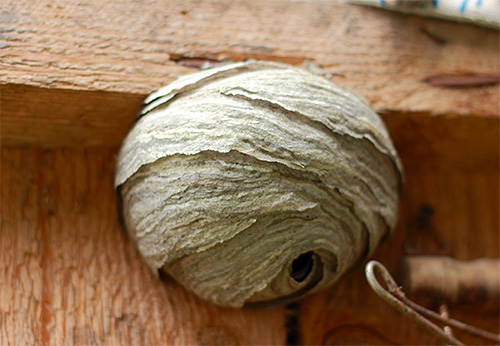

In high-density horticultural communities, wasps are almost certain to take up residence on someone's property. Bypassing the neighbors, you can eventually find the "lucky one" who has their nest hanging in the attic or in the toilet, and often several at once. In addition, in apiaries or in the neighborhood of ownerless territories, you can catch a couple of wasps in leather gloves, tie scarlet ribbons around their abdomen, release them and track where they fly. Literally in half an hour you can find their nest.
Read about how to properly destroy wasp and hornet nests in other articles on our website (section "Hornets and Wasps"). We also recommend that you check out the helpful video below.
Interesting video: making an effective wasp trap from improvised means




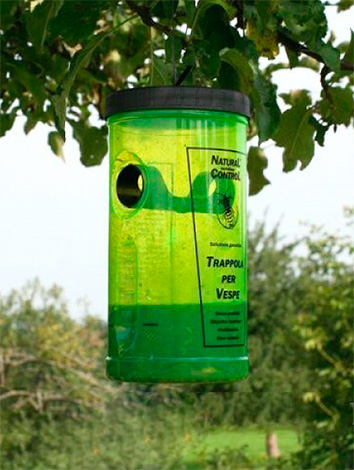


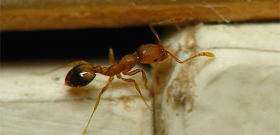
Thank you! Helped a lot)
This is a pipets, there is no salvation from them at all, just wait for the winter.The creatures are volatile, the more you kill them, the more of them appear.
Also faced the problem. The nest is located under the roof in a very inaccessible place, it is reluctant to disassemble, and I was afraid of a furious swarm. Here I hung a couple of Velcro, wasps stick in huge quantities, some fall immobilized into a substituted bucket, but with all this they do not become smaller ... I will try the bottle you described.
In general, thanks for the article and good luck in destroying the wasps.
Thank you very much. I am a beginner summer resident, the issue with wasps is the most painful for me!
All articles are great. Thank you.